Urban developers are seeking to transform public areas through a people-centric approach, Xing Yi reports in Shanghai.
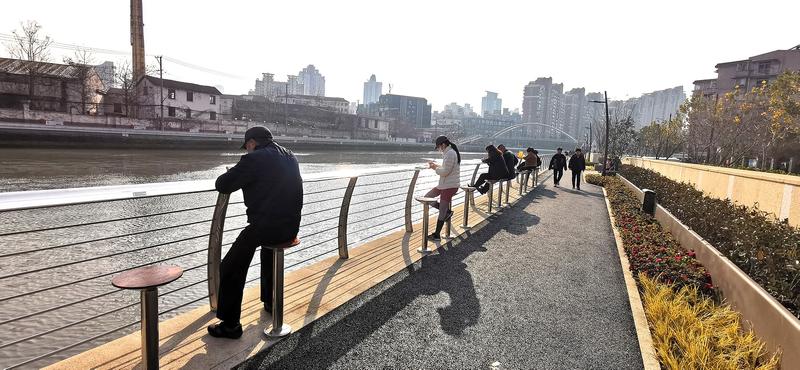 Micro-renewal projects to elevate the surrounding neighborhood along the Suzhou Creek are favored by residents. (XU XIAOMIN / CHINA DAILY)
Micro-renewal projects to elevate the surrounding neighborhood along the Suzhou Creek are favored by residents. (XU XIAOMIN / CHINA DAILY)
Despite living in a city that has one of the highest population densities in the world-more than 23,000 people live per square kilometer in the downtown area-the residents of Shanghai have seen public spaces mushroom over the past five years as the campaign for micro-renewal of urban spaces continues to gather pace.
But with few open spaces, developers have had to get creative with their approach. For instance, public amenities such as sports equipment, activity rooms, benches and jogging trails have been introduced in formerly underutilized and sealed off spaces like beneath overpasses, deserted warehouses and basements of old housing communities.
The city is like a sensitive forest ecosystem — both towering trees and underground microbes play roles.
Tong Ming, principal architect at TM Studio
The title of a design contest on urban renewal aptly describes these pockets of development in the city as "a metamorphosis at your doorstep".
Organized by the Shanghai Commission of Housing and Urban-Rural Development, the recent contest saw dozens of participants submit proposals for renewal plans for 101 locations in the city.
Zhu Weikun, a master's student of urban planning at Tongji University, is part of a team that saw its proposal accepted. Sixty-four teams had their plans approved for implementation.
"I was thrilled when the organizer told us that we will get a chance to implement our design and turn the blueprint into reality," says Zhu, who participated in the contest in November with her classmates.
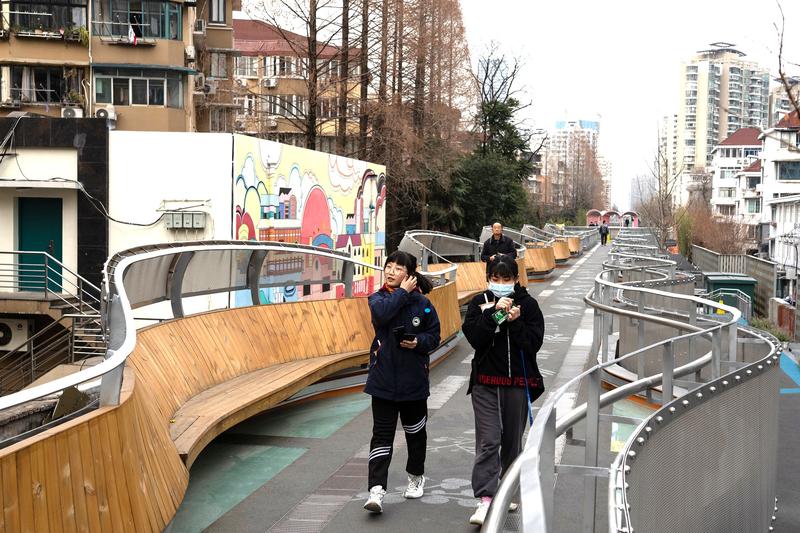 Newly renovated Caoyang Centennial Park, which used to be an old railway market (bottom picture), features areas for art, sport and casual activities and is a popular spot in Putuo district. (GAO ERQIANG / CHINA DAILY)
Newly renovated Caoyang Centennial Park, which used to be an old railway market (bottom picture), features areas for art, sport and casual activities and is a popular spot in Putuo district. (GAO ERQIANG / CHINA DAILY)
Under bridges
The site Zhu and her classmates chose in their renewal plan was the 500-meter stretch beneath the elevated rail of Dabaishu Station in Yangpu district on subway Line 3. The area is currently occupied by rail pillars, small stores, parking lots and pockets of greenery.
"Due to the lack of good design, the space could not be fully utilized by people even though there is a creative industry park next to it," says Zhu, who along with her classmates visited the site many times to take measurements and observe human activity in the surrounding area.
"There are many abrupt ends on the sidewalk, and people have to walk on the car lane," she says. "As such, the first thing we made was to redesign the traffic lane and make the area an unimpeded corridor for people to walk."
According to the team's plan, the corridor will be divided into three functional areas. One area will be a sports zone, with exercise and children's recreational facilities. The other will be an informal business zone with a small convenience store, benches and boxes for meetings. The third zone, which will be at the southern end of the corridor, will become a park with a themed exhibition on the Shanghai-Woosung railway system.
"During my observations, I noticed a boy who couldn't go through the corridor because of the existing blockage and had to instead walk on the traffic lane," says Zhu. "I hope that when my design is implemented, people will find this area more enjoyable and safe to walk in."
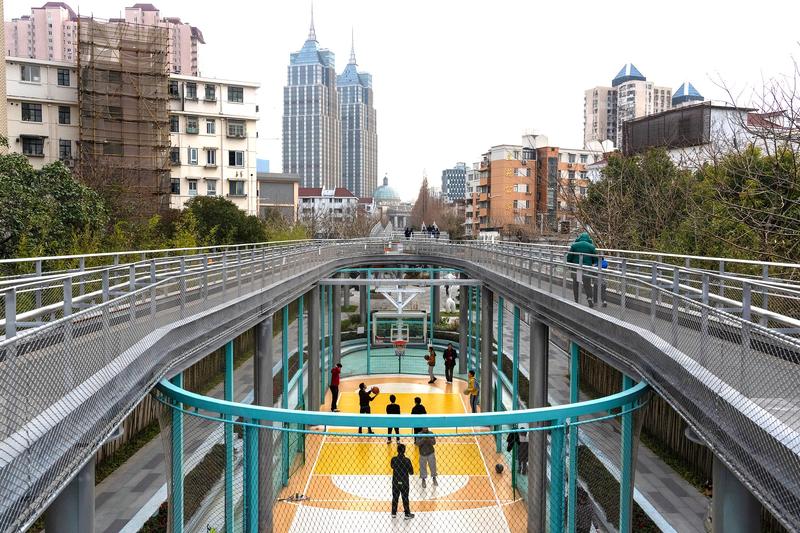 People play basketball in the park. (GAO ERQIANG / CHINA DAILY)
People play basketball in the park. (GAO ERQIANG / CHINA DAILY)
The idea of turning the underutilized areas beneath bridges and highways into functional spaces is fairly new to Shanghai-the concept was piloted in the city in 2018 when the Shanghai Urban Public Space Design Promotion Center launched a micro-renewal project titled "revitalizing space under bridges".
Wang Mingying, an officer with the promotion center, which recently merged with the Shanghai Urban Planning and Design Research Institute, says the renovation of such spaces is a tall task because it involves coordination across multiple administrative bodies, including the transport department, environment department and the subdistrict government.
"The pilot was a good start. We are now seeing more and more people paying attention to such areas," says Wang.
Because of this project, art installations now fill the space under the bridges over Kaixuan Road and Gubei Road. An animal-themed sports park, comprising two small soccer fields and nine basketball courts under the Middle Ring Overpass on Beidi Road, was unveiled to the public in July. Many spaces under the bridges across the Suzhou Creek were also renovated and adorned with paintings and lights during the city's riverside renovation project in 2020.
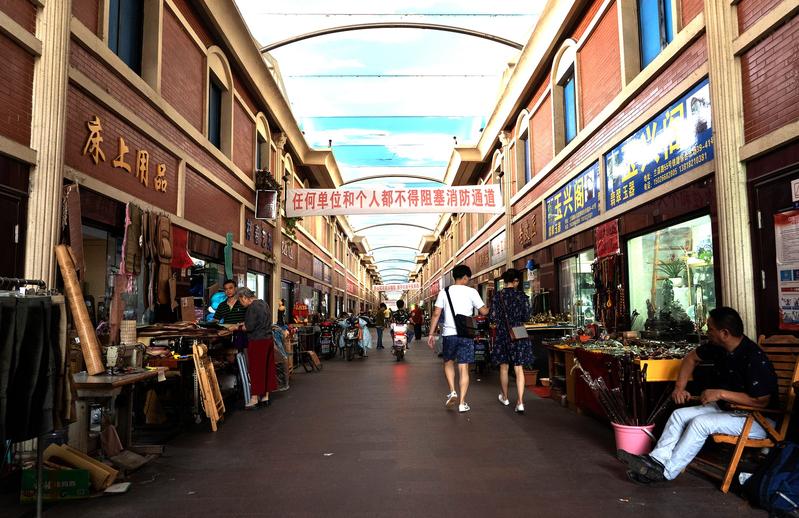 A pre-renovation photo features Caoyang Railway Market, the once longest wet market in Shanghai. (GAO ERQIANG / CHINA DAILY)
A pre-renovation photo features Caoyang Railway Market, the once longest wet market in Shanghai. (GAO ERQIANG / CHINA DAILY)
Community involvement
The Shanghai Urban Public Space Design Promotion Center was one of the first city bodies to promote the concept of micro-renewal. The center also highlights good practices at the Shanghai Urban Space Art Season that it has been organizing every two years since 2015. Last season's theme was "15-minute community life circle-people's city "that featured designs for community service facilities and amenities that cater to residents' needs in living, working, relaxing, studying and elderly care.
"Micro-renewal projects provide opportunities for people to practice local governance. By inviting grassroots participation, the people-centered approach of urban planning can focus more on local needs," says Wang.
Free-Down Space, formerly an empty air-defense basement in the Hongxian residential neighborhood in Changning district, is one good example of community involvement.
Zhang Huan, a member of the social organization Big Fish Community Building and Development Center, has been leading this community's micro-renewal project since 2019. Last year, the organization turned the space into a multifunctional activity zone of 1,100 square meters. Featuring bright colors, the basement is now partitioned into areas, including a reading room, cafe, children's room and spaces that host art studios and startup offices.
Zhang Lingdi, a housekeeper who has been living in the neighborhood for nearly 30 years, is among those who have leased a space there-she uses it for Ayi's Home, a platform for her peers to rest, share job information and organize activities.
"In September, we started a weekly Sunday Shanghainese Corner, where we teach young people the Shanghai dialect," she says. "The colorful space has made my retired life more colorful."
Another notable community micro-renewal project can be found in the Dongming subdistrict of Pudong district where social organization Clover Nature School has been spearheading a campaign to build community gardens in the area of 5 square kilometers since 2020. The organization also held a community garden festival over October and November.
Liu Yuelai, a professor at Tongji University who co-founded the organization, says the community gardens can serve as pathways that enhance bonds among people and bolster sustainable community renewal.
"There are many wasted 'negative spaces' in the city, and we can reactivate them through participatory design. Community gardens are a good vehicle to do so," he says.
Through workshops and consultations, Liu's team has helped residents to design their own gardens in deserted lots or mismanaged patches of greenery. The district's residents have currently designed about 20 small gardens.
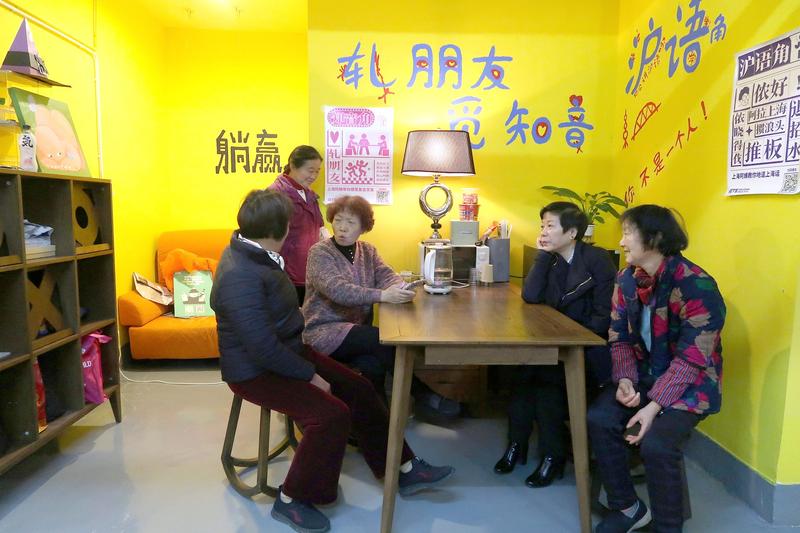 Residents rest and chat in Free-Down Space, formerly an air-defense basement in the Hongxian residential neighborhood. (XING YI / CHINA DAILY)
Residents rest and chat in Free-Down Space, formerly an air-defense basement in the Hongxian residential neighborhood. (XING YI / CHINA DAILY)
Commercial interest
Commercial developers have also been jumping on the urban-regeneration bandwagon. Among them is AECOM China, an infrastructure consulting firm, which plans to transform an old electrical equipment factory on Wuyi Road into an office space. The company advised the property owner to hollow out the first floor stores on the street side for a pedestrian arcade, and open a small pocket square at the entrance of the old Shanghai alleys on the property for public use.
"It may seem like we are taking a step back in the commercial sense, but the people-centric design will increase the popularity of the building and boost both the economic and social value of the property and nearby area," says Michael Ma, vice-president of economics for AECOM China.
"Good renewal projects that bring benefits and raise the living quality will eventually create value for the property owner," he says, adding that as the development of downtown Shanghai becomes saturated, there will be more urban regeneration projects.
"When we make micro-renewal efforts to elevate the surrounding neighborhood environment, we will achieve a win-win for the public and business," says Ma.
Similar projects have already reaped commercial gains. For example, in one project on Yuyuan Road, a store of 9 square meters that was turned into a "public-story wall" has attracted some 2,000 people to share their stories in just two months and significantly increased footfall in the area. Another example is the 900-meter-long section between Jiangsu Road and Dingxi Road, which has been turned into a leisure space, featuring lawns and flower beds over 130 square meters that families in the area enjoy.
Xu Yinlan, the general manager of branding for CREATER, the developer behind the project, says this section used to be chaotic before 2019 as it was crammed with illegal structures, small restaurants and foot massage shops.
"The city is like a sensitive forest ecosystem-both towering trees and underground microbes play roles, but it is the small units such as retail outlets and cultural facilities that contribute to the diversity and inclusiveness," says Tong Ming, principal architect at TM Studio, a Shanghai-based architectural office.
"Good micro-urban renovation can bring vigor to a declining environment and drive the social and economic development in its neighborhood," says Tong, who is also an expert on the urban planning committee of the municipal government. "We can compare it to traditional acupuncture therapy or minimally invasive surgeries that treat many 'urban diseases' in big cities."
Contact the writer at xingyi@chinadaily.com.cn


